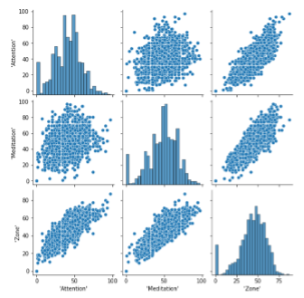K-Means for Majoring Informatics Students' Interests Based on Brainwave Signals
DOI:
https://doi.org/10.12928/mf.v5i1.6629Keywords:
Brainwave, K-Means, Clustering, Principal Component Analysis, SilhouetteAbstract
This study investigates the potential of utilizing EEG (electroencephalogram) as a determinant for the specialization choices of Informatics students. EEG, measuring brain activity patterns, is employed to discern majors of interest among students. A questionnaire revealed that some students opt for specializations due to class availability and peer influence, leading to potential mismatches between their abilities and interests, consequently affecting their final project or thesis. EEG data from 30 respondents, recorded using NeuroSky Mindwave and MyndPlayer Pro software, were subjected to K-Means Clustering after feature extraction through PCA. However, the evaluation using Silhouette indicated a low score of 0.453, possibly due to significant distance between cluster data and centroids, minimal dataset size, and random respondent selection without considering their specific areas of interest. This suggests limitations in using EEG alone for determining specialization choices, necessitating further refinement and integration with additional factors for more accurate predictions.
References
A. Azhari, “Analisis Pengaruh Cognitive Task Berdasarkan Hasil Ekstraksi Ciri Gelombang Otak Menggunakan Jarak Euclidean,” p. 6, 2017.
A. Azhari and L. Hernandez, “Brainwaves feature classification by applying K-Means clustering using single-sensor EEG,” Int. J. Adv. Intell. Informatics, vol. 2, no. 3, p. 167, Nov. 2016, doi: 10.26555/ijain.v2i3.86.
Y. Akbar, “Pola Gelombang Otak Abnormal Pada Elektroencephalograph,” p. 6.
M. Teplan, “Fundamentals Of Eeg Measurement,” Measurement Science Review, vol. 2, p. 11, 2002.
F. Yumiko, I. I. Tritoasmoro, and H. Fauzi, “Klasifikasi Sinyal Eeg Terhadap Konsentrasi Individu Menggunakan Metode K-Nearest Neighboor,” p. 16.
Md. Z. Hossain, Md. N. Akhtar, R. B. Ahmad, and M. Rahman, “A dynamic K-means clustering for data mining,” IJEECS, vol. 13, no. 2, p. 521, Feb. 2019, doi: 10.11591/ijeecs.v13.i2.pp521-526.
K. P. Sinaga and M.-S. Yang, “Unsupervised K-Means Clustering Algorithm,” IEEE Access, vol. 8, pp. 80716–80727, 2020, doi: 10.1109/ACCESS.2020.2988796.
S. K. Mukhiya and U. Ahmed, Hands-On Exploratory Data Analysis with Python. Packt Publishing Ltd., 2020.
S. Morgenthaler, “Exploratory data analysis,” WIREs Comp Stat, vol. 1, no. 1, pp. 33–44, Jul. 2009, doi: 10.1002/wics.2.
R. Pujianto and A. A. Rahmawati, “Analisis Ekstraksi Fitur Principle Component Analysis pada Klasifikasi Microarray Data Menggunakan Classification And Regression Trees,” p. 12.
O. D. Nurhayati, D. Eridani, and A. Ulinuha, “Ekstraksi Ciri Orde Pertama dan Metode Principal Component Analysis untuk Mengidentifikasi Jenis Telur Ayam Kampung dan Ayam Arab,” J. Sistem Info. Bisnis, vol. 9, no. 2, p. 133, Nov. 2019, doi: 10.21456/vol9iss2pp133-140.
S. K. Prabhakar and H. Rajaguru, “PCA and K-means clustering for classification of epilepsy risk levels from EEG signals — A comparitive study between them,” in 2015 International Conference on Intelligent Informatics and Biomedical Sciences (ICIIBMS), Okinawa, Japan, Nov. 2015, pp. 83–86. doi: 10.1109/ICIIBMS.2015.7439467.
M. H. Dunham, “Data Mining Introductory and Advanced Topics,” pp. 140–141.
S. Paembonan and H. Abduh, “Penerapan Metode Silhouette Coeficient Untuk Evaluasi Clutering Obat,” vol. 6, no. 2, p. 7, 2021.
S. Aranganayagi and K. Thangavel, “Clustering Categorical Data Using Silhouette Coefficient as a Relocating Measure,” in International Conference on Computational Intelligence and Multimedia Applications (ICCIMA 2007), Sivakasi, Tamil Nadu, India, Dec. 2007, pp. 13–17. doi: 10.1109/ICCIMA.2007.328.
T. Thinsungnoen, N. Kaoungku, P. Durongdumronchai, K. Kerdprasop, and N. Kerdprasop, “The Clustering Validity with Silhouette and Sum of Squared Errors,” in The Proceedings of the 2nd International Conference on Industrial Application Engineering 2015, 2015, pp. 44–51. doi: 10.12792/iciae2015.012.
X. Wang and Y. Xu, “An improved index for clustering validation based on Silhouette index and Calinski-Harabasz index,” IOP Conf. Ser.: Mater. Sci. Eng., vol. 569, no. 5, p. 052024, Jul. 2019, doi: 10.1088/1757-899X/569/5/052024.
S. Morshad, Md. R. Mazumder, and F. Ahmed, “Analysis of Brain Wave Data Using Neurosky Mindwave Mobile II,” in Proceedings of the International Conference on Computing Advancements, Dhaka Bangladesh, Jan. 2020, pp. 1–4. doi: 10.1145/3377049.3377053.

Downloads
Published
Issue
Section
License
Copyright (c) 2023 Qori Aulia Robin, Ahmad Azhari

This work is licensed under a Creative Commons Attribution-ShareAlike 4.0 International License.
Start from 2019 issues, authors who publish with JURNAL MOBILE AND FORENSICS agree to the following terms:
- Authors retain copyright and grant the journal right of first publication with the work simultaneously licensed under a Creative Commons Attribution License (CC BY-SA 4.0) that allows others to share the work with an acknowledgment of the work's authorship and initial publication in this journal.
- Authors are able to enter into separate, additional contractual arrangements for the non-exclusive distribution of the journal's published version of the work (e.g., post it to an institutional repository or publish it in a book), with an acknowledgment of its initial publication in this journal.
- Authors are permitted and encouraged to post their work online (e.g., in institutional repositories or on their website) prior to and during the submission process, as it can lead to productive exchanges, as well as earlier and greater citation of published work.

This work is licensed under a Creative Commons Attribution-ShareAlike 4.0 International License.












 Mobile and Forensics (MF)
Mobile and Forensics (MF)